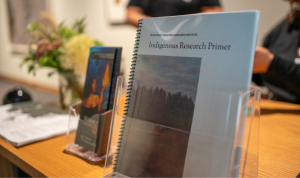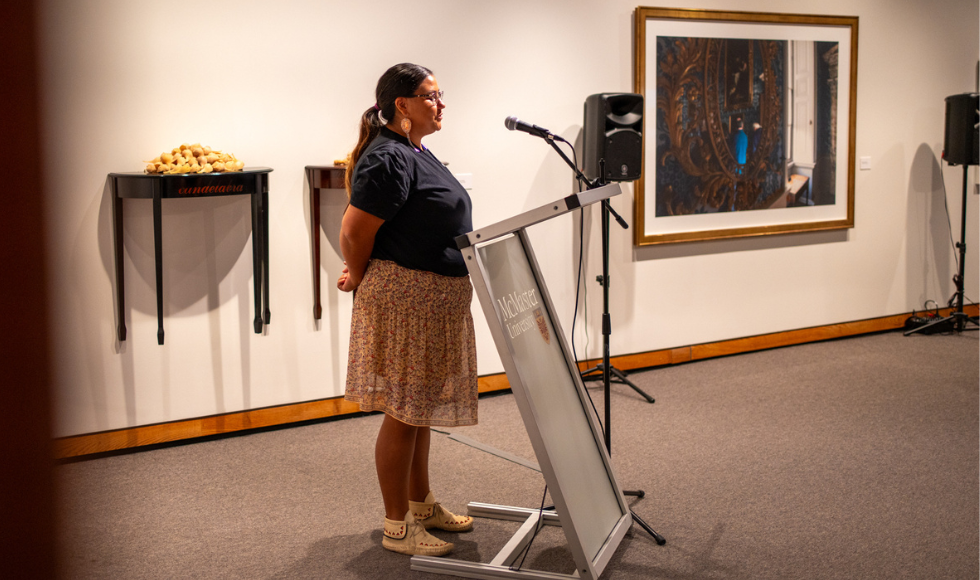New research primer offers wealth of guidance, resources for Indigenous research

Anishinaabe drummer Lissa Lavallee opens the launch of the MIRI Research Primer at the McMaster Museum of Art. The Primer offers insights on working with Indigenous Peoples and communities to conduct community-driven research in an ethical, appropriate and effective way. (All photos by Christian Braun, McMaster University)
The McMaster Indigenous Research Institute (MIRI) has created a much-needed guide for researchers whose work engages with Indigenous Peoples and communities.
 The MIRI Indigenous Research Primer emphasizes the need for meaningful, respectful and ethical collaboration at every step of the way in all research, and offers guidance to ensure this need is met.
The MIRI Indigenous Research Primer emphasizes the need for meaningful, respectful and ethical collaboration at every step of the way in all research, and offers guidance to ensure this need is met.
The primer offers guidance on community-based participatory research with communities, rather than the outdated and unethical practice of research on them; Indigenous methodologies and research paradigms, and what to do if a community does not consent to proposed research.
Launched this fall, the primer is very much a living document — an ongoing work that will continue to expand, grow and evolve, says lead creator and MIRI research coordinator Katelyn Knott.
“It’s been a labour of love,” Knott said at the primer’s launch event, held at the McMaster Museum of Art in September. She spoke surrounded by powerful works of art from the museum’s Chasm exhibition, which critiques the power dynamics of colonialism, especially where it affects Indigenous and Black people.

The need for a primer
“Historically, Indigenous people have been exploited when it comes to research,” says MIRI director Savage Bear.
For generations, research involving Indigenous Peoples and communities has been conducted without consulting them or considering their needs. They have been treated as subjects of research, rather than participants and partners.
“It’s been an extractive industry for researchers and we’re looking to make sure that that doesn’t happen any more,” Bear says.
“We want researchers — both Indigenous and non-Indigenous — to remain accountable for the things they write, and the protocols they follow.”

Community-based participatory research
Combining research, education and action, community-based participatory research is a crucial aspect of any work involving Indigenous Peoples and communities. Engaging at every stage with elders and community partners who serve as coordinators, this approach ensures the full and enthusiastic participation of community members, and considers the impact of the outcome on the lands and peoples.
“As researchers, we all have our curiosities. We have our passions and our interests,” Bear notes. “But when you want to work with an Indigenous community or individuals, none of these might be their concern. We need to follow the community’s lead.
“And, as with many things, when a community says no, it’s no.”
Three pillared approach
The primer itself is one pillar of a three-pillared approach to knowledge and understanding that represents the body, the mind and the spirit, a holistic way of engaging researchers and community members, Knott notes.
The document of the primer outlines Indigenous Ways of Knowing, or the body. A series of short video clips showcasing a diverse range of researchers talking about their work reflects the Ways of Being, or the mind. And quarterly sharing sessions that will involve community members and Indigenous methodology researchers will serve as the Ways of Doing, or the spirit, connecting the other two pillars.
Two Row Research Paradigm
The primer also incorporates the Two Row research paradigm, drawing on the Two Row Wampum Agreement of 1613, which establishes ways in which two peoples from different laws and beliefs can co-exist in a healthy relationship.
As outlined by McMaster researchers and their research partners, the Two Row Research Paradigm is based on five key principles: Ongoing dialogue in all relationships; the importance of place; equity within distinctiveness of Indigenous communities; pluralism and diversity; and sharing knowledge, rather than owning it.
The primer also offers insights into navigating institutional processes while using research methodologies, and a robust list of resources for further information.


